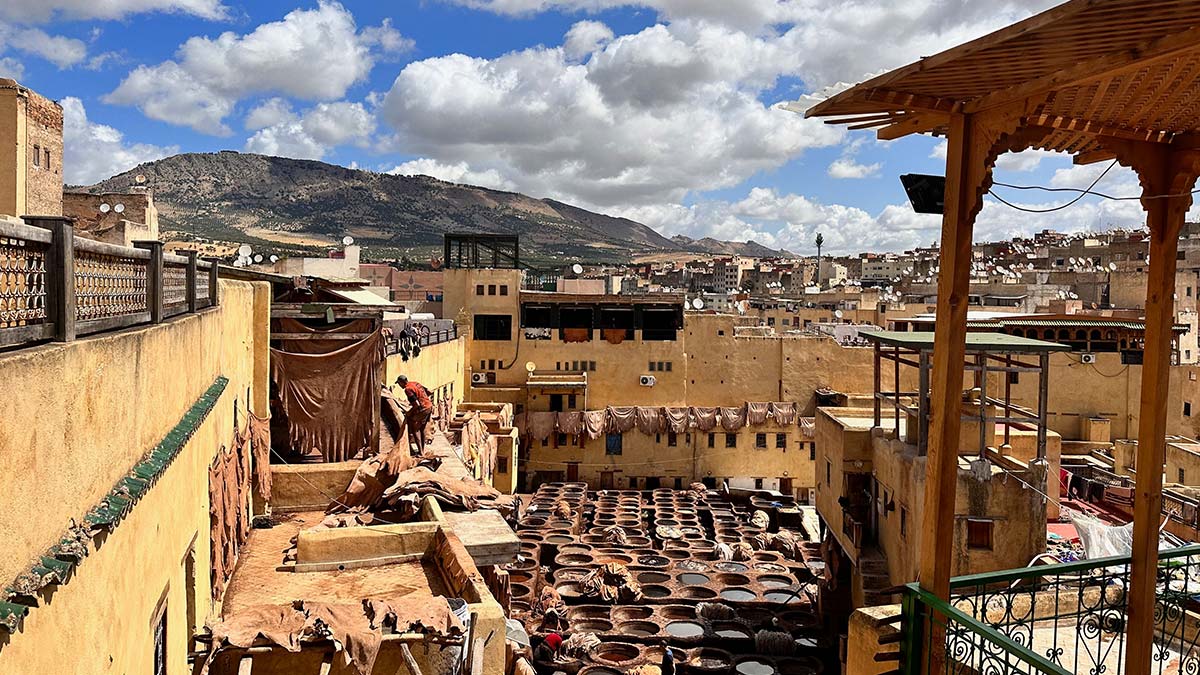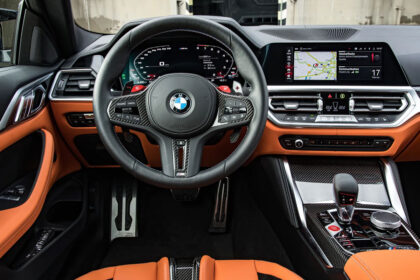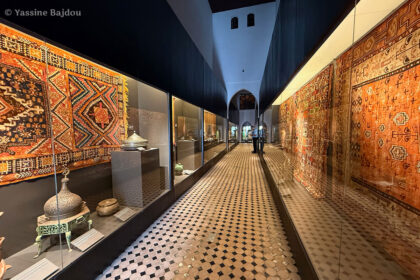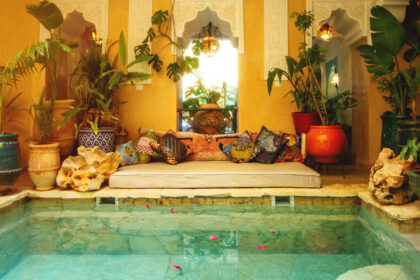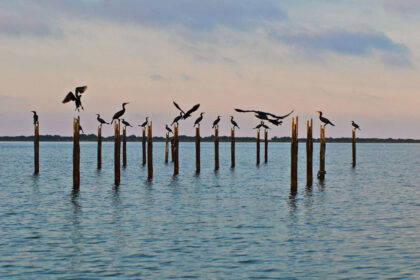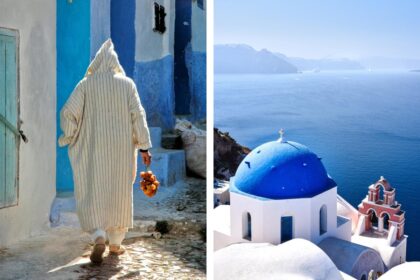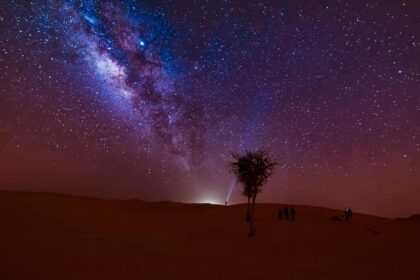For all souvenir aficionados, Morocco is a shopaholic’s dream come true. One may arrive with empty suitcases and enjoy filling them with exotic, colourful clothes, jewellery and beauty products. For the craft-minded, there are souks that have an abundance of fabrics, tassels, beads, sequins and braiding to take home and adorn oneself or to transform one’s decor.
- 1. Kaftans, Djellabas and other Clothing.
- 2. Turbans, Headscarves and Hats.
- 3. Babouche.
- 4. Leather Clothing and Poufs.
- 5. Woven Baskets and Straw Bags.
- 6. Berber Rugs, Carpets and Blankets.
- 7. Lanterns and Lamps.
- 8. Metalwork.
- 9. Silver Jewellery.
- 10. Fossils and Crystals.
- 11. Ceramics
- 12. Argan Oil.
- 13. Rose Water and Rose Oil.
- 14. Artisanal Soap and Cosmetics.
- 15. Tea, Teapots and Tea Glasses.
- 16. Spices and Dry Goods.
- 17. Olives, Dates and Sweets.
- 18. Wooden Boxes.
- 19. Musical Instruments.
- 20. Paintings.
Fabulous light fitments, crockery and glassware which can easily be shipped internationally by the vendors can be found aplenty. Leather goods are also an excellent buy. Many come to Morocco stock up on locally made leather products like boots and handbags and see the tanneries in action. Browsing the market stalls and bargaining can be great fun. And there are plenty of smaller goods that make great souvenirs from Morocco as well; keyrings, fridge magnets, mugs and postcards are all cheap as chips!
Many of these goods are much cheaper than the prices in Europe or the USA. And don’t forget that you are contributing much-needed money to the local economy.
And talking of price:
HAGGLE!
The byword here is “haggle” Always bargain over the price, even if the vendor has a “fixed price”. Whatever the seller may ask for, offer at least fifty percent less as a starting point, and then work your way to a price that you are both happy with. Pretending to walk away is a good tactic as is having a maximum amount that you are prepared to pay.
Don’t go above this. If you’re looking to buy a more pricey item like a carpet, the merchant may invite you to take a glass of tea with him. It’s fine to accept if you are serious about a possible purchase. Sometimes vendors may appear to be angry. Just leave, and if you can go back the next day, you will be greeted like a long-lost brother.
When all is done, you should think that you have come away with a bargain and the vendor will have made a profit so both parties should be happy. Look up the “Life of Brian” haggling scene on YouTube to get a flavour of what to expect!
MONEY.
Note that most Moroccan shops and market stalls don’t take credit cards, so make sure you have lots of cash. The Moroccan currency is the Dirham. 10 Dhs is about equal to one US dollar. Always check the prices in a few different establishments where possible to get a better idea of a reasonable price.
Prices in bigger cities are usually higher than those in smaller towns and rural areas and check out side streets and alleyways for bargains as tourist hotspots and main streets are generally more expensive.
If you are unable to visit Morocco at this time, don’t fret as Morocco souvenirs online are easy to find and can be reasonably priced if you look around.
So let’s have a look at our recommended The 20 Best Souvenirs to Buy in Morocco:
1. Kaftans, Djellabas and other Clothing.
Many of the kaftans, djellabas and dresses produced in Moroocco are hand-made, embroidered by hand and quite exquisite. And with a bit of haggling can be exceedingly good value. Tunic tops and blouses are other good buys. One must be careful with brightly coloured items as they are often not colour-fast so should be washed separately on the first couple of occasions.
For men, there are djellabas, which are kaftans with a hood, hats and thobes, a sort of long dress. I wear a thobe all the time in the summer, it’s so cool! But I’m not sure I’d wear it in the UK or the USA, so think about practicality. If you have time, you can have a suit or other item tailor-made at a good price.
You can also purchase baggy pants with a drawstring. These are loose-fitting, light and very comfortable. Harem trousers are also available.
As well as the souks, check out the boutiques in the new town for contemporary fashions and styles that still utilize traditional designs.
- Best Places to Buy: Everywhere and anywhere! Regional variations occur. Casablanca for modern boutiques.
- Price Guide: A basic kaftan from 50 to 100 Dhs.150 Dhs for a more elaborate one. Shirt or blouse; 100 Dhs. A very intricate dress might cost you 2,000 to 20,000 Dhs!
2. Turbans, Headscarves and Hats.
Headscarves or hijabs can be purchased anywhere in a wide variety of styles and colours. Headscarves and turbans are particularly recommended for desert treks. The vendors will happily teach you how to tie a turban correctly. Blue is the traditional colour for these except in Merzouga where black scarves are worn, brightly embroidered. Other colours are aimed at tourists.
Brightly coloured, broad-brimmed hats with tassels are unique to the Tangier area, Fezzes are a great purchase in Fes, of course.
- Best Places to Buy: Headscarves – anywhere, turbans – Merzouga.
- Price Guide: 30 to 70 Dhs for a headscarf/hijab or turban.
3. Babouche.
Moroccan pointy leather slippers. Very comfortable and cheap, great for casual wear indoors and out. Yellow is the most popular traditional colour with Moroccans, but other colours are available. Don’t buy the ones with glued-on soles as they quickly fall to pieces. Babouche make ideal souvenirs from Morocco as they are cheap, essentially Moroccan and easy to slot into a suitcase.
- Best Places to Buy: Fes, Rissani., Marrakech where there is a whole street named after them.
- Price Guide: From 50 to 80 Dhs.
4. Leather Clothing and Poufs.
Leather clothing shops are found all over the country and provide excellent souvenirs The 20 Best Souvenirs to Buy in Morocco. It’s worth visiting the Chouara tanneries in Fes to see how the products are produced by traditional methods much the same as they were hundreds of years ago and then look around the dozens of shops that surround the courtyard for a bargain or two.
Different animal hides are used to produce the leather including cow, sheep, goat, horse and camel. The smell in the tanneries is awful, so you may be offered a sprig of mint to hold under your nose. Full-length leather coats, brightly coloured jackets, trousers, belts, wallets, purses, handbags, shoes and slippers, all at very reasonable prices if you haggle. Unusually for Morocco, the Chouara tannery does accept credit cards.
The lovely leather poufs that you see in the souks look much too large to take home but, fear not, when you buy one it comes unstuffed and easy to fit flat in your suitcase. So choose the design and colour scheme that you prefer and the shopkeeper will be happy to provide you with an empty one that you can stuff at home. You will see these all over the world in stores, but they are naturally much cheaper in Morocco.
- Best Places to Buy: Chouara tannery in Fes, Marrakech, Rissani.
- Price Guide: About half what you would expect to pay in Europe or the USA. A leather jacket with lambskin lining from 1,000 to 3,000 Dhs. Medium leather bag – 500 Dhs. Purse 100 to 150 Dhs. Wallet 80 to 100 Dhs: For the poufs; 150 to 350 Dhs depending on size and quality.
5. Woven Baskets and Straw Bags.
Very fashionable at the moment, there is a wide variety of different styles of straw bags and woven baskets available across Morocco. Whole shops can be dedicated to these which come in different sizes, colours, shapes and functions. Some vendors can even add sequins, tassels, pompoms or embroidery at your request, or you can buy these extras separately and do it yourself at home. Bread baskets are large wool and straw woven trays used in restaurants and riads and may be plain or brightly coloured.
- Best Place to Buy: Marrakech especially at the souk near the Cafe de Espices and Tangier.
- Price Guide: 100 Dhs for a large bag. Bread basket – 40 to 50 Dhs.
6. Berber Rugs, Carpets and Blankets.
You can find woven Berber rugs, carpets and blankets for sale all across North Africa, but we believe that the Moroccan ones are the best. Found in traditional and modern designs in a plethora of colours, the quality is judged on the type of fabric, the dyes used and the number of knots per square metre. Many of them are works of art. The prices can be astronomical, but you pay for quality and these pieces are hand-crafted on ancient looms often by equally ancient women with decades of experience. This is where haggling skills are really important, Bargaining for rugs and carpets can take a while over a glass of mint tea, but it is possible to reduce the starting price greatly. And remember, a good quality rug will last a lifetime.
You can find woven Berber rugs, carpets and blankets for sale all across North Africa, but we believe that the Moroccan ones are the best.
One word of warning; keep an eye on your rug all the way through the transaction until you leave with it. A common scam is for the vendor to wrap a cheaper rug for you when you’re not looking.
Incredible, unique, brightly-coloured woollen blankets can be found in almost every shop in Chefchaouen. Often blue like the walls of the town, these make wonderful wall decorations as well as perfect gifts. They also produce shawls in similar styles and colours.
- Best Places to Buy: Berber villages, the back streets of Marrakech for carpets and rugs, Chefchaouen for blankets.
- Price Guide: Be prepared to remortgage your house for a large, high-quality carpet, but smaller, lesser-quality rugs and blankets can be reasonably priced. A cheaper rug will be about 1,000 Dhs, but a really decent one will cost you a few thousand Dhs.
7. Lanterns and Lamps.
Some shops in the larger cities sell only locally made lanterns and lamps. Some are freestanding and some are for hanging. Many are made from beaten brass or pewter and peppered with tiny holes. Some have glass and others are just metal. Be careful as some of the cheaper lamps are made from metals that rust and discolour.
Aluminium framed lanterns are particularly affordable but tend to bend easily. Ask the shopkeeper to place a light inside the lamps in which you are interested so that you can see the amount of light and the beautiful glow it produces. Compare the very variable quality of the metalwork.
- Best Places to Buy: Fes, Meknes, Marrakech.
- Price Guide: 100 Dhs for a cheap lamp or lantern. 200 to 500 Dhs for a good quality metal and glass lamp. 300 Dhs for a metal lamp up to 2,000 Dhs for large standing lamps.
8. Metalwork.
Hand-hammered metalwork can be seen being produced in the Seffarine Square in Fes and other souks across the country. It’s interesting to see the craftsmen at work but the noise is deafening. Many pieces are decorative etched metal but there are also practical items such as teapots, bowls and trays. Machine-stamped objects are also available and are cheaper. It’s fairly easy to spot the difference just by looking. Machine-manufactured pieces are uniform whereas hand-hammered items are a bit more uneven but somehow much more charming. Items are made from brass, bronze, pewter, copper and even silver,
- Best Places to Purchase: Fes and Sefrou.
- Price Guide: Dependent on quality and the type of metal used.
9. Silver Jewellery.
Moroccan men and women love to wear silver jewellery, especially men as Islam forbids them to wear gold. For women, rings and necklaces are commonplace plus earrings and hair ornaments. The prices are good as Morocco is the leading producer of silver ores in Africa. The Jewish people in the cities began to produce the most beautiful and intricate silver items and after the majority of the Jews left for Israel, the Muslim Moroccans have successfully taken over the craft.
Beware as there are a lot of fakes about. Silver doesn’t smell metallic, so if your item does, it’s probably an imitation.
- Best Places to Buy: Medinas of the bigger cities.
- Price Guide: Very variable, pay what you think the item is worth to you.
10. Fossils and Crystals.
Hundreds of palaeontologists, geologists, gemologists and amateur fossil and crystal collectors come to Morocco every year for the wealth of excellent quality and rare fossil and mineral specimens the country produces. Thousands more purchase online. And for the passing tourist, these pieces provide something different and beautiful.
Everything from a polished ammonite to a dinosaur tooth can be found here, Haggle and you’ll get a price a fraction of what you’d pay online or in fossil shops and fairs in other countries. You can even buy washbasins and fountains made of fossils if you want something totally different. Check out the preparation centres and wholesalers in Erfoud for amazing pieces and roadside stalls throughout the Atlas Mountains for bargains.
But be careful; there are a lot of fakes and composites around as well.
- Best Places to Buy: Erfoud, Villages and roadside stalls in the south and the Atlas Mountains, Marrakech.
- Price Guide: From 20 Dhs for a small ammonite or common trilobite up to thousands for a beautifully prepped specimen or something rare or large.
11. Ceramics
Ceramic and pottery shops can be found in all the medinas and markets in Morocco and exhibit a huge range of products. I like to visit the potteries in Ain Nockbi, a suburb of Fes, where you can watch the products being made, purchase bargains and even have something made to order if you have the time.
Plates, cups, mugs, bowls, tajines, tiles, ashtrays; earthenware, plain, two-tone, or brightly coloured, each region of the country has a different style and favoured colour scheme. Tajines are very Moroccan. Both the dish they’re cooked in and the food have the same name. They are earthenware bowls with a cone-shaped top. If the top has a hole in the centre, it is practical but if not it is purely decorative. They can be plain or brightly coloured.
As well as the potteries, there are large wholesalers which offer products cheaper than most of the shops. The shopkeepers usually wrap your purchases well, but always ensure you have wrapping yourself as some of these products are very fragile and we don’t want that sinking feeling one gets on returning home to find your prized plate is smashed to bits.
You will also see a lot of beautiful ceramic tiles in some shops. These tiles are used by the Moroccans for floors and walls and you see them everywhere. It takes ten years as an apprentice before you are considered to be a master tile maker and these artists produce the most gorgeous designs. The tiles have to be made upside down and then sealed, so it takes memory as well as skill to remember the designs and shapes that you are creating. Seeing this process in action is amazing and a tile or two make excellent souvenirs to buy in Morocco.
- Best Places to Buy: For ceramics: Fes, Meknes, Safi and Rabat. For tiles: Ain Nokbi, Fes and Tetouan.
- Price Guide: Small ceramic items from 20 Dhs, big ones 200-300 Dhs. Tagines 20 to 100 Dhs.
Tiles can be hundreds of dirhams due to the time and craftsmanship that goes into them.
12. Argan Oil.
Argan oil is produced from nuts of the Argania tree found only in southwest Morocco. Goats often climb the trees to eat the nuts and this is quite comical to behold. They then pass the nuts which are collected by the local people or the people pick the fruit and extract the nuts which are then roasted to extract the oil.
In the past, this was all done slowly in small villages but then large corporations arrived with oil presses destroying the economy of the Berber people of the region. Thankfully, the King ordered government aid and along with NGOs they have provided the equipment needed for local women and formed cooperatives to bring the much-needed cash back to the villages.
Argan oil is said to be healthier than olive oil when used for culinary purposes and it is great for dipping bread and drizzling on pasta. A different variety is also in skincare and to strengthen hair. You will need to specify which type you require; culinary or cosmetic.
The quality varies and can be determined by texture, colour and aroma. A good product should be thick, yellow and have a nutty aroma. There are also argan soaps and hand creams available,
- Best Places to Buy: Villages in the Agadir, Essaouira and Marrakech areas and those cities.
- Price Guide: 75 to 150 Dhs for 100 ml of cosmetic argan oil, 250 Dhs for a litre of good quality cooking oil.
13. Rose Water and Rose Oil.
On the second weekend in May (usually) in the small town of Keelat-M’Gouna in the Dades Valley, there is held the annual Festival Of Roses. Rose water and rose oil are produced that will keep your linen smelling fresh for weeks and are great as a perfume and for aromatherapy too. They make ideal souvenirs from Morocco but can be quite expensive as it takes 10,000 roses to make 5ml. Of rose oil. The products can be bought all year around all over Morocco, but is cheaper in the Dades Valley.
- Best Places to Buy: Dades Valley.
- Price Guide: 250 Dhs for a 10 ml bottle.
14. Artisanal Soap and Cosmetics.
Moroccan artisanal black soap feels wonderful on the skin. High in alkalis and vitamin E, they are made from olive oil and olives and have a gel-like consistency when wet. They are healthy, cleansing, exfoliating and moisturising. To exfoliate, Moroccans use the soap with a kessa, a rough cloth that is rubbed over the skin ten minutes after the soap has been washed off, This is also used in the hammams.
Other handmade soaps are made with added argan oil, lavender, jasmine, orange blossom water, or rosemary and smell wonderful.
Ghassoul is a cosmetic made from mineral clay and has been used by Moroccan women for centuries to cleanse the skin.
Kohl is a black eyeliner which is very much part of Moroccan culture.
- Best Places to Buy: Cosmetic shops, hammams and souks all across Morocco.
- Price Guide: 20 to 30 Dhs for a bar.
15. Tea, Teapots and Tea Glasses.
Tea is the National Drink of Morocco and is served everywhere in tall glasses, Poured from height to mix in oxygen, often with a lot of sugar and a sprig of mint it is delicious and refreshing. The teapots are often hand-crafted from metal and can be works of art in themselves, resembling a genie’s lamp. Moroccan hospitality will usually include offering a pot of tea and tea is served for family and friends.
The teapots make great souvenirs from Morocco as does the tea itself. There are also tea shops that sell a variety of loose-leaf green tea and packets and tins of dried tea. A set of tea glasses can also be beautiful, though fragile. Beldi Glass is a good brand.
- Best Places to Buy: Everywhere in Morocco.
- Price Guide: Really cheap! A small bag of tea is about 20 Dhs. Teapots from 150 to 300 Dhs, Etched bowls and plates 100 to 500 Dhs. Plain metalwork is naturally cheaper than etched products.
16. Spices and Dry Goods.
The multi-coloured, cone-shaped mounds on top of barrels full of spice in the spice shops of Morocco are beautiful in themselves and the aromas are gorgeous. Spices are considerably cheaper in Morocco than in Europe or the USA and the flavour and quality are higher. You can ask the proprietor of the outlet to grind the spices fresh for you and they make superb souvenirs of Morocco as they take up barely any space in your luggage. Saffron, ras al hanout (top of the shop), cumin, cinnamon, white pepper, cayenne, ginger, paprika, sesame seeds, aniseed and turmeric are amongst the best buys.
Saffron is orange to yellow at the base and deep red at the tip. If you see it entirely deep red it has been dyed. It should also look like a small flower with a stalk that splits into two or three and is flared in appearance, It should smell slightly musty.
Ras al hanout is the Moroccan special made with ten or more different herbs and spices and even includes dried rose petals!
Then the dried goods retailers have excellent value walnuts, almonds and figs.
But beware of some of these shops in tourist areas as they often overcharge, Try to shop where the locals do.
- Best Places to Buy: Generally everywhere in Morocco. But where they grow and are in season is preferable when possible. So almonds in the spring up north, saffron from Tailouine, etc.
- Price Guide: Saffron 40 – 80 Dhs for a gram. For 100 grams; Ras al hanout 40 Dhs, Turmeric cumin, paprika 20 Dhs, Ginger, pepper, cinnamon 15 Dhs, Dried Mint and others 10 Dhs.
17. Olives, Dates and Sweets.
Some shops sell only dates and sometimes figs and there is a huge variety of types, flavours, stickiness, sweetness and price! Other retailers specialise in olives, I like them with a little harissa (spicy, red paste) added to the bag. Buy the olives and dates close to when you leave, if possible, for maximum freshness!
Sweets/candy are delicious and cheap, The nougat, plain, or with nuts or honey, often brightly coloured with natural ingredients can be gift-wrapped and make an ideal souvenir of Morocco.
- Best places to Buy: Olives just about anywhere, dates also but preferably in the south where they grow. Nougat in Casablanca and Marrakech.
- Price Guide: Very cheap.
18. Wooden Boxes.
The speciality in half the shops in Essaouira medina is wooden trinket/jewellery boxes and puzzle boxes made from the local Thuya wood, polished and often inlaid with mother of pearl, lemonwood, cedar, or bone. Thuya is a bush that is indigenous to Morocco and grows in abundance in the Essaouira region.
Because so many shops are competing with each other, it is quite easy to get a bargain if you haggle and move from store to store,
The puzzle boxes provide great fun trying to discover how to open them, which bits to push or slide in which order to reveal the key to open the lid.
- Best Place to Buy: Essaouira Medina, Agadir, Marrakech.
- Price Guide: From 20 to 100 Dhs or more depending on the size, quality, materials used, or complexity of the puzzle boxes.
19. Musical Instruments.
In the medinas of Morocco and in villages especially in the south you can find the occasional shop or stall selling musical instruments. Some are indigenous Berber instruments and some were introduced by the Arabs. Most sellers are happy to play for you or even give you a lesson. The Arabic guitar called the oud can be purchased anywhere in Morocco but the Berber instruments are usually found in the south.
Hand drums are ubiquitous, fun to play and come in a range of sizes. These are played in Morocco’s festivals, weddings and other celebrations. Gnawa hand and finger cymbals are also popular and inexpensive purchases. Inexpensive, simple wooden flutes are a super buy for the children.
Do not buy the banjo-like instruments made from tortoise shells. Tortoises are in danger of extinction in Morocco.
- Best places to Buy: Marrakech, Agadir, Essaouira, towns near the Sahara Desert.
- Price Guide: Cymbals 20 Dhs. Other instruments depend on quality, size and age,
20. Paintings.
Some of the contemporary Moroccan artists are extremely talented and for this reason, Moroccan art is much sought after in some quarters. In the medinas, you will find art shops exhibiting the work of local artists in a wide range of styles. Often they are simple scenes of children in the streets, buildings, or a sunset. I have a gorgeous painting of a traditional staircase in Fes. An excellent souvenir to buy in Morocco that will only increase in value.
- Best Places to Buy: Medinas across the country.
- Price Guide: Very reasonable, but haggle for an even better bargain.







